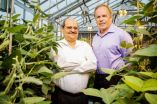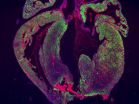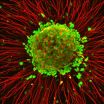(Press-News.org) BOSTON – Much has been reported about the potential for increased risk of alcohol misuse after weight loss surgery (WLS), with most theories pointing to lower alcohol tolerance and a longer time to return to a sober state after surgery, but a new study from Beth Israel Deaconess Medical Center suggests that upwards of half of high-risk drinkers are actually less likely to report high-risk drinking behavior after weight loss surgery.
The results appear in the journal, Surgery for Obesity and Related Diseases.
"This is the first study to show that high-risk drinking may actually improve post weight loss surgery," says lead author and principal investigator Christina Wee, MD, Director of Obesity Research in the Division of General Medicine and Primary Care.
Wee and colleagues interviewed patients who participated in the Assessment of Bariatric Surgery or ABS Study, which aims to understand patient preferences and decision making processes about weight loss and weight loss surgery. They followed 541 clinically obese patients who underwent weight loss surgery, interviewing them at baseline and then twice again at the end of one and two years.
Study participants were asked questions assessing frequency of drinking over the past year, quantity of alcohol consumed on an average daily, and binge drinking over the past month. Results were used to determine which individuals were high-risk drinkers.
"Given the greater clinical attention being paid to caloric intake and substance abuse issues after WLS, we hypothesized that a subset of high-risk drinkers who undergo WLS may actually experience amelioration of their high-risk drinking," write the authors.
It turns out they were right.
"So much of the existing literature focuses on increased risk", says senior author George Blackburn, MD, Director of the Center for Nutrition Medicine. "Even though we expected to see something different with this data, we were still surprised by the findings."
About one in six patients reported high-risk drinking before weight loss surgery. At one year after surgery two thirds of gastric bypass patients and nearly half of gastric banding patients reported ceasing high-risk drinking. And at year two "half of gastric bypass and more than half of gastric banding patients reported this improvement," write the authors.
"It's possible that previous studies may have missed this positive effect because post-surgery alcohol use wasn't compared against baseline consumption," says Wee.
While this decrease in high-risk drinking is important, the study also found that seven percent of weight loss surgery patients who did not report high-risk drinking at baseline reported new high-risk drinking at year one and two years post-surgery. These findings were similar between gastric bypass and gastric banding patients.
Wee thinks understanding the complete picture can better prepare clinicians to counsel their patients who are considering weight loss surgery and follow up with them after surgery.
"Often, high-risk drinkers are steered away from weight loss surgery. Knowing that a significant percentage of these patients may actually cease high-risk drinking after weight loss surgery may help us recommend more patients for surgery," says Wee.
"We routinely screen for alcohol misuse as part of routine pre- and post-operative care, with a heavy emphasis on patients who are known to be at risk," says co-author Dan Jones, MD, Director of BIDMC's Bariatric Surgery Center. "This study tells us that we can do a better job of screening for and supporting patients who are newly at risk as opposed to only focusing on those who may have had a problem before surgery."
Wee says more research is necessary to understand why weight loss surgery seems to help some patients improve alcohol misuse, while it increases misuse in others. "We also need to better understand which patients are at highest risk for developing alcohol misuse so that we might better counsel and monitor them."
INFORMATION:
In addition to Wee, Blackburn and Jones, study authors include Kenneth Mukamal, MD, MPH, Karen Huskey, MPH, Roger Davis, ScD of Beth Israel Deaconess Medical Center; Mary Ellen Colten, PhD and Dragana Bolcic-Jankovic, MA, from University of Massachusetts, Boston; and Caroline Apovian from Boston Medical Center.
Beth Israel Deaconess Medical Center is a patient care, teaching and research affiliate of Harvard Medical School, and currently ranks third in National Institutes of Health funding among independent hospitals nationwide.
The BIDMC health care team includes Beth Israel Deaconess Hospital-Milton, Beth Israel Deaconess Hospital-Needham, Beth Israel Deaconess Hospital-Plymouth, Anna Jaques Hospital, Cambridge Health Alliance, Lawrence General Hospital, Signature Health Care, Commonwealth Hematology-Oncology, Beth Israel Deaconess HealthCare, Community Care Alliance, and Atrius Health. BIDMC is also clinically affiliated with the Joslin Diabetes Center and Hebrew Senior Life and is a research partner of Dana-Farber/Harvard Cancer Center. BIDMC is the official hospital of the Boston Red Sox. For more information, visit http://www.bidmc.org.
Study shows more than half of high-risk alcohol users report improvement after surgery
Previous reports on alcohol use after weight loss surgery may miss these positive effects
2014-04-03
ELSE PRESS RELEASES FROM THIS DATE:
Aging workforce requires new strategies for employee retention, MU researcher says
2014-04-03
COLUMBIA, Mo. – As more baby boomers reach retirement age, state governments face the likelihood of higher workforce turnover. For example, in the state of Missouri, more than 25 percent of all active state employees will be eligible to retire by 2016. Such large numbers of retirees threaten the continuity, membership and institutional histories of the state government workforce, according to Angela Curl, assistant professor in the University of Missouri School of Social Work. In a case study of the state of Missouri's Deferred Retirement Option Provision (BackDROP), Curl ...
Scientists say new computer model amounts to a lot more than a hill of beans
2014-04-03
CHAMPAIGN, Ill. — Crops that produce more while using less water seem like a dream for a world with a burgeoning population and already strained food and water resources. This dream is coming closer to reality for University of Illinois at Urbana-Champaign researchers who have developed a new computer model that can help plant scientists breed better soybean crops.
Under current climate conditions, the model predicts a design for a soybean crop with 8.5 percent more productivity, but using 13 percent less water, and reflecting 34 percent more radiation back into space, ...
Dress and behavior of mass shooters as factors to predict and prevent future attacks
2014-04-03
New Rochelle, NY, April 3, 2014–In many recent incidents of premeditated mass shooting the perpetrators have been male and dressed in black, and may share other characteristics that could be used to identify potential shooters before they commit acts of mass violence. Risk factors related to the antihero, dark-knight persona adopted by these individuals are explored in an article in Violence and Gender, a new peer-reviewed journal from Mary Ann Liebert, Inc., publishers. The article is available free on the Violence and Gender website at http://www.liebertpub.com/vio.
In ...
Ouch! Computer system spots fake expressions of pain better than people
2014-04-03
BUFFALO, N.Y. — A joint study by researchers at the University of California, San Diego, the University at Buffalo, and the University of Toronto has found that a computer–vision system can distinguish between real or faked expressions of pain more accurately than can humans.
This ability has obvious uses for uncovering pain malingering — fabricating or exaggerating the symptoms of pain for a variety of motives — but the system also could be used to detect deceptive actions in the realms of security, psychopathology, job screening, medicine and law.
The study, "Automatic ...
New study casts doubt on heart regeneration in mammals
2014-04-03
The mammalian heart has generally been considered to lack the ability to repair itself after injury, but a 2011 study in newborn mice challenged this view, providing evidence for complete regeneration after resection of 10% of the apex, the lowest part of the heart. In a study published by Cell Press in Stem Cell Reports on April 3, 2014, researchers attempted to replicate these recent findings but failed to uncover any evidence of complete heart regeneration in newborn mice that underwent apex resection.
"Our results question the usefulness of the apex resection model ...
Hummingbirds' 22-million-year-old history of remarkable change is far from complete
2014-04-03
The first comprehensive map of hummingbirds' 22-million-year-old family tree—reconstructed based on careful analysis of 284 of the world's 338 known species—tells a story of rapid and ongoing diversification. The decade-long study reported in the Cell Press journal Current Biology on April 3 also helps to explain how today's hummingbirds came to live where they do.
Part of the secret to the birds' remarkable success lies in the formation of nine principal groups or clades, hummingbirds' unique relationship to flowering plants, and the birds' continued spread into new ...
Lactase persistence alleles reveal ancestry of southern African Khoe pastoralists
2014-04-03
In a new study a team of researchers lead from Uppsala University show how lactase persistence variants tell the story about the ancestry of the Khoe people in southern Africa. The team concludes that pastoralist practices were brought to southern Africa by a small group of migrants from eastern Africa. The study is published in Current Biology today.
"This is really an exciting time for African genetics. Up until now, routes of human migration in Africa were inferred mostly based on linguistics and archaeology, now we can use genetics to test these hypotheses." says ...
Cancer and the Goldilocks effect
2014-04-03
Researchers at the University of California, San Diego School of Medicine have found that too little or too much of an enzyme called SRPK1 promotes cancer by disrupting a regulatory event critical for many fundamental cellular processes, including proliferation.
The findings are published in the current online issue of Molecular Cell.
The family of SRPK kinases was first discovered by Xiang-Dong Fu, PhD, professor in the Department of Cellular and Molecular Medicine at UC San Diego in 1994. In 2012, Fu and colleagues uncovered that SPRK1 was a key signal transducer ...
Study helps unravel the tangled origin of ALS
2014-04-03
MADISON, Wis. — By studying nerve cells that originated in patients with a severe neurological disease, a University of Wisconsin-Madison researcher has pinpointed an error in protein formation that could be the root of amyotrophic lateral sclerosis.
Also called Lou Gehrig's disease, ALS causes paralysis and death. According to the ALS Association, as many as 30,000 Americans are living with ALS.
After a genetic mutation was discovered in a small group of ALS patients, scientists transferred that gene to animals and began to search for drugs that might treat those ...
Patient stem cells help identify common problem in ALS
2014-04-03
Harvard stem cell scientists have discovered that a recently approved medication for epilepsy may possibly be a meaningful treatment for amyotrophic lateral sclerosis (ALS)—Lou Gehrig's disease, a uniformly fatal neurodegenerative disorder. The researchers are now collaborating with Massachusetts General Hospital to design an initial clinical trial testing the safety of the treatment in ALS patients.
The investigators all caution that a great deal needs to be done to assure the safety and efficacy of the treatment in ALS patients, before physicians should start offering ...
LAST 30 PRESS RELEASES:
New evidence challenges understanding of Parkinson’s disease
A new study reveals how embryos and the uterus “talk” during implantation
Cedars-Sinai reports heart attacks, general illness spiked after LA fires
PolyU develops ultra-stable, mucus-inspired hydrogel to boost gastrointestinal wound healing
Flour choice shapes sourdough microbial communities
Can a retinal implant reverse macular degeneration?
Feeding fungi plant remnants produces tasty protein to fortify vegan, vegetarian diets
New tech reduces false positives from breast ultrasounds
Drone-mounted lab monitors fertilizer runoff in real time
Short, light-intensity exercise boosts executive function and elevates mood in children
Jeonbuk National University researchers reveal new interface engineering strategy for efficient and stable back-contact solar cells
Tyrosinase drives hydroquinone-induced exogenous ochronosis: not HGD inhibition
UMass Amherst chemists develop unique tool for studying RNA
Disappointment alters brain chemistry and behavior
A built-in odometer: new study reveals how the brain measures distance
Stress-related brain signals drive risk of cardiovascular disease in people with depression and anxiety
New details on role of fat transport molecules in Alzheimer’s onset
Study illuminates how an antiviral defense mechanism may lead to Alzheimer’s disease
Spot the males: New gene-editing method could transform mosquito control
AI learns to build simple equations for complex systems
NAU team releases 13 years of detailed U.S. CO2 emissions data
Unveiling how sodium-ion batteries can charge faster than lithium-ion ones
How do childcare tax credits affect children’s long-term health?
Can an electronic nose detect indoor mold?
Do natural disasters have long-term impacts on mortality in older adults?
Modification improves sodium‐ion batteries as an alternative to lithium-ion batteries
Parasports provide a range of benefits for people with cerebral palsy
How does grandparental care affect children’s health?
Why are there so many Nordic mediators?
Young shark species more vulnerable to extinction
[Press-News.org] Study shows more than half of high-risk alcohol users report improvement after surgeryPrevious reports on alcohol use after weight loss surgery may miss these positive effects





